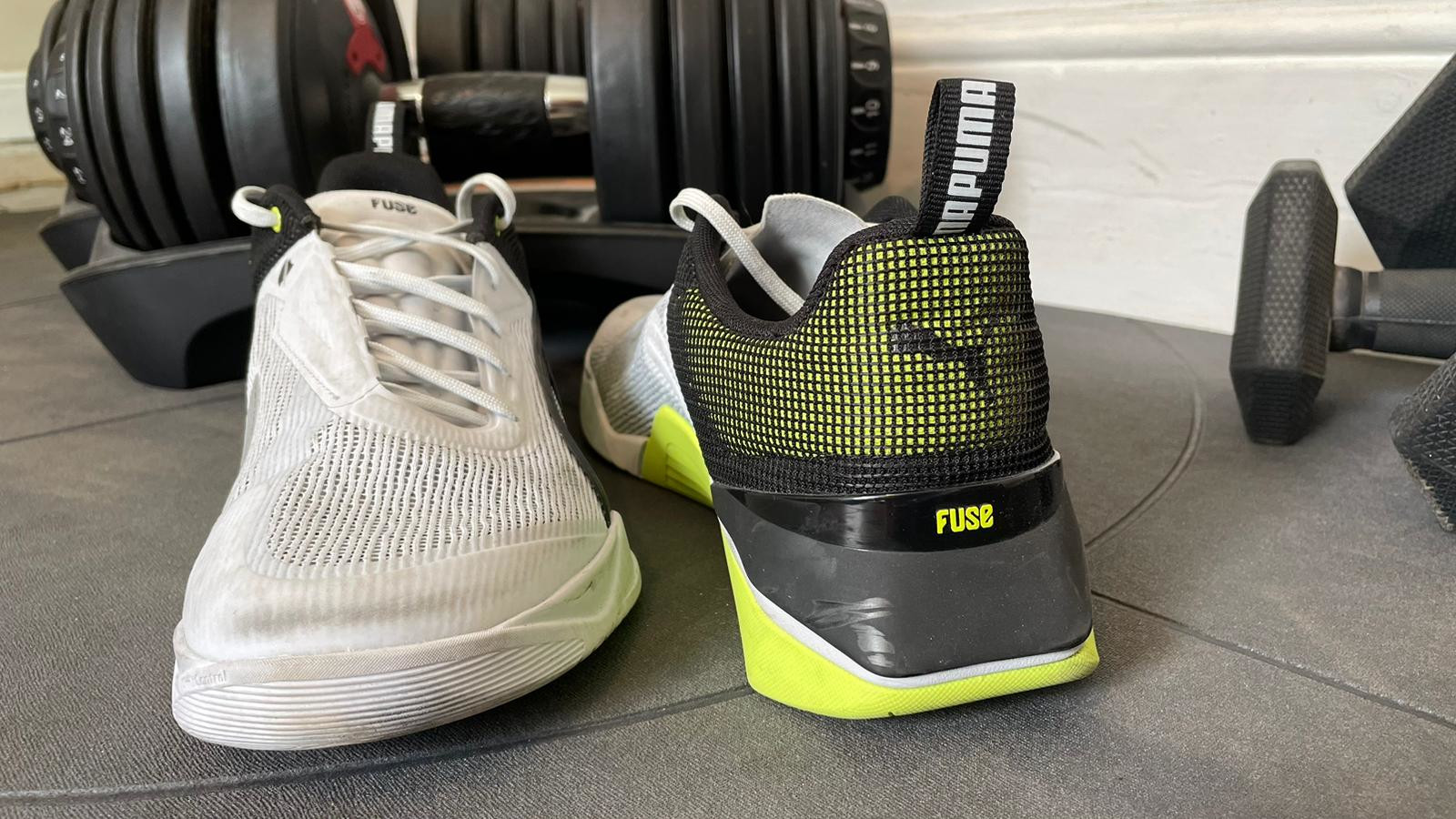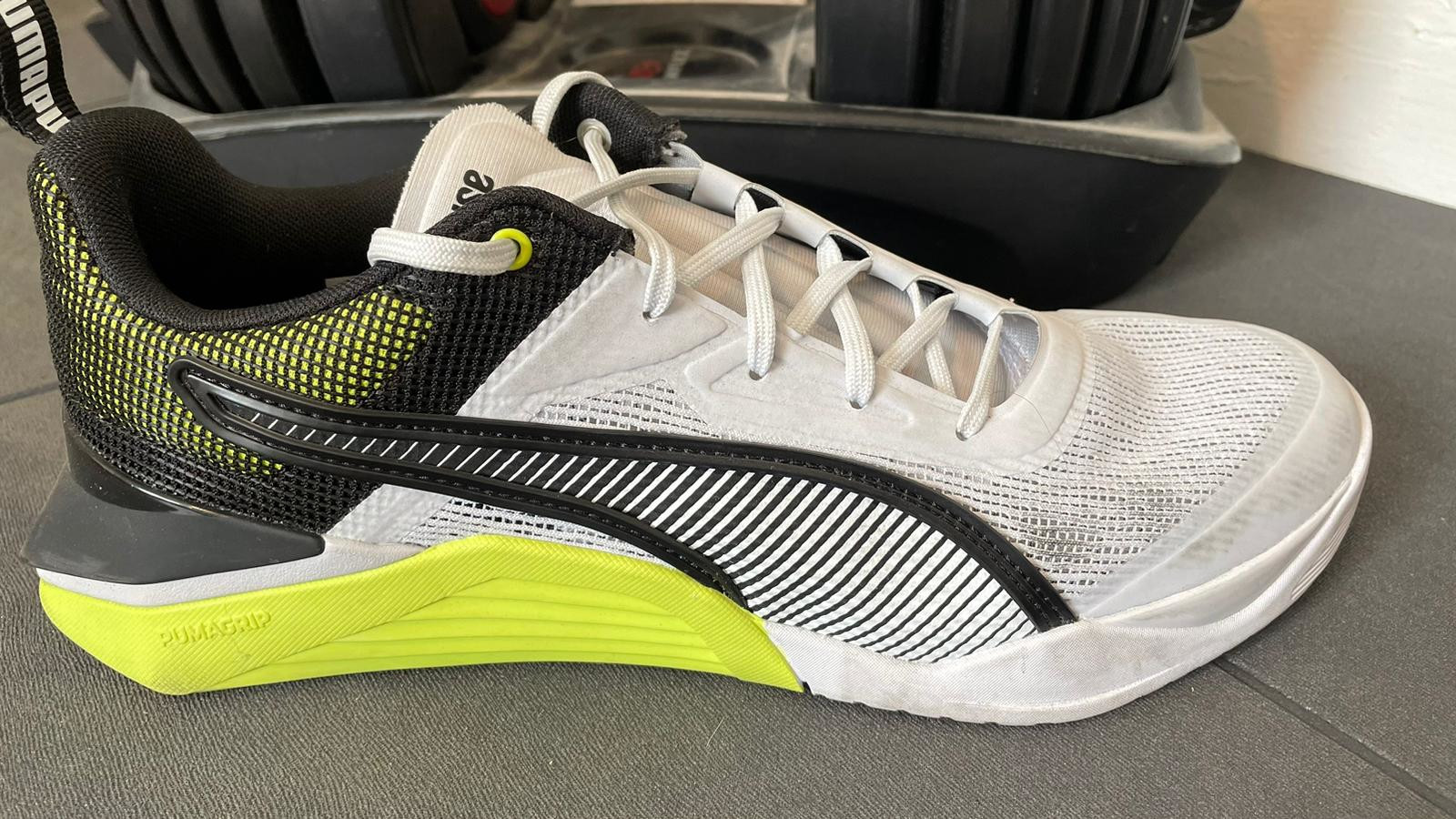Our Verdict
The third generation of the Puma Fuse is a radical departure from what came before. It sacrifices the soft, sock-like upper of its predecessors for a sturdy, stability-focused build which is better for weightlifting. It’s a move Puma needed to make to compete with the big hitters of the CrossFit world, but the added weight is noticeable and I miss the comfort of the 2.0.
For
- Stable for weight lifting
- Robust build
Against
- Heavy
- Narrow forefoot
- Unappealing design
You can trust Coach
The Puma Fuse 2.0 has been my favorite budget CrossFit shoe for some time, delivering superior comfort and a springy yet supportive midsole that’s suitable for pretty much any WOD. So when its successor was released with a $20 higher retail price, the pressure was on for the brand to deliver.
The dramatic nature of Puma’s redesign was apparent to me as soon as I pulled them on. The upper feels firmer, the forefoot seems narrower, the shoe is noticeably heavier and the heel is a different beast entirely thanks to several new stability features.
Overall, I do believe the upgrade has furthered Puma’s mission to make the best CrossFit shoe, but this might be a case of taking one step back to take two forward.
Puma Fuse 3.0: Price And Availability
The Puma Fuse 3.0 costs $120 in the US and £100 in the UK. That’s a $20/£10 price rise on the Puma Fuse 2.0 and brings the 3.0 more in line with well-established CrossFit shoe brands, which typically charge north of $130.
The Puma Fuse 2.0 was often discounted and I’d expect the 3.0 to follow suit so it may be worth shopping around after six months.
How I Tested This Shoe
I wore this shoe for two weeks of no-holds-barred training in the lead-up to the CrossFit Open, using it for 10 90-minute-plus training sessions in that time.
Each one started with some strength work or Olympic weightlifting, followed by gymnastics practice, a varied WOD and some accessory lifts.
Sign up for workout ideas, training advice, reviews of the latest gear and more.
It’s also been used for its fair share of shoe-destroying moves such as wall walks, rope climbs and handstand push-ups that come as standard in a CrossFit training program.
Design

The look of the Puma Fuse 3.0 isn’t to my taste. The design is busy and blocky, with raised detailing around the Puma logo and an angular heel.
Some of those elements do serve a purpose, though. The pointed edges on either side of the angular heel mean it doesn’t roll when pushed sideways, delivering a solid platform for catching Oly lifts.
There are also sturdy heel and toe guards for protection during wall walks and handstand push-ups, along with extra raised rubber sections around the midsole for rope climbs and lateral support.

This catalog of new stability features delivered just that: superior stability. But they do add weight to the shoe, making it feel less nimble than its predecessor. The Puma Fuse 3.0 weighs 454g in my UK size 10. The Puma Fuse 2.0 is 405g and my one-time favorite TYR CXT-1 is 348g.
Is The Puma Fuse 3.0 Good For WODs?
I love the Puma Fuse 2.0 for WODs. It’s lightweight and breathable, with a responsive midsole foam that was a dream when bounding onto boxes.
The Puma Fuse 3.0? Not so much. This is mainly because it has a fair amount of weight to it and the heel in particular felt heavy whenever I tried to move quickly in fast-paced workouts.
It beats its predecessor for stability thanks to the redesigned heel, and there’s no questioning the purchase afforded by the PUMAGRIP outsole. As a result I quite liked the shoe for barbell-heavy workouts like Grace.
But as soon as I had to move fast, I noticed the shoe’s heavy heel. This was particularly apparent during longer workouts like a 40-minute EMOM I tackled while wearing them.
Is The Puma Fuse 3.0 Good For Resistance Training?
This is where the Puma Fuse 3.0 is at its best. The angular edges of the outsole that flare out from the heel stop any unwanted rolling and the PUMAGRIP design offers great grip.
The midsole feels firm under heavy weights too, with none of the unwanted compression I experienced with past models. As a result, it provides a firm foundation for generating power during squats, cleans, snatches and more.
The only drawback is that the forefoot feels narrow and squashed, even though Puma claims it has “widened the last” of the shoe. This left me less able to spread my toes for balance than I would have liked.

Is The Puma Fuse 3.0 Good For Running?
The restrictive forefoot and weight meant that the Puma Fuse 3.0 didn’t impress during short (up to 400m) mid-WOD running intervals.
Compared with other CrossFit shoes I’ve tried, it didn’t feel as nimble, springy or energetic, although it wasn’t as clunky as the Nike Metcon 9.
No CrossFit shoe is made to handle more than a couple of kilometers—this just wouldn’t be possible while maintaining a firm enough midsole for lifting. But most still offer a bit of bounce from a thin layer of midsole cushioning, and I felt that was missing here.
Is The Puma Fuse 3.0 Worth It?

I’m going to save you some money here. If you want a great budget CrossFit shoe, buy the Puma Fuse 2.0. If you want Puma’s best CrossFit shoe, buy the Puma Fuse 2.0. In fact, if you want a great CrossFit shoe full stop, you could still buy the Puma Fuse 2.0.
The main problem with the Puma Fuse 2.0 was its lack of stability in the heel, with a little compression in the heel when under heavier weights. The Puma Fuse 3.0 has solved this problem, delivering a superbly stable heel with an innovative angular design to stop unwanted lateral movement. This is something the brand needed to fix to compete for the title of “best CrossFit shoe”—but the improvements have come at a cost.
The shoe feels heavy during WODs, the weighting seems to be off in favor of the back of the shoe, the midsole lacks energy and my foot feels uncomfortably cramped along the sides of the midfoot and forefoot.
I’m hoping Puma can marry the stability of this shoe with the attributes of its predecessor with its next functional fitness-focused release. But for now, the unparalleled comfort of the Fuse 2.0 makes it my preferred Puma training shoe.

Harry covers news, reviews and features for Coach, Fit&Well and Live Science. With over a decade of training experience, he has tried everything from powerlifting to gymnastics, cardio to CrossFit, all in a bid to find fun ways of building a healthy, functional body.

